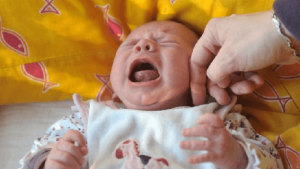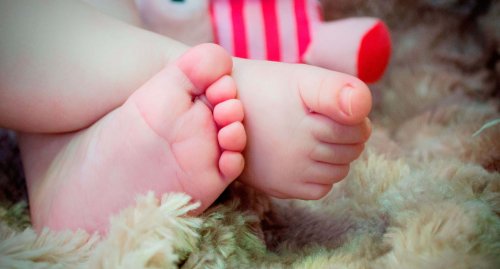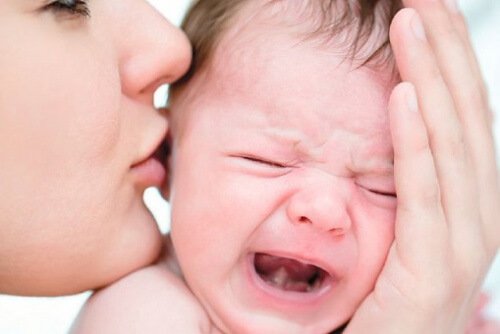Signs You Should Call the Pediatrician Immediately

When you are a first time mother, sometimes every little thing can seem so alarming and visits to the pediatrician can be constant. Of course, if something is worrying you, the first thing you should do is call the pediatrician to be assured your baby is okay.
However, today we want to talk to you about some signs you should be familiar with, because if they happen to your baby, you will have to visit your pediatrician immediately.
They Have Very Cold Hands and Feet
If your baby’s feet and hands feel cold, you should place your hands on their torso and feel their temperature there. If their torso is warm and pink, then nothing is wrong.
Your baby’s circulatory system is still developing and their blood is more often diverted to vital organs and systems, because that is where it is most needed. That is why their hands and feet are the last parts of the body to receive good blood supply.
It can take up to three months for babies’ circulation to fully adapt to life outside the womb. In the meantime, it is common for little ones to have colder hands and feet than normal.
As your baby begins to move around more, their circulation will start to improve. But go to your pediatrician if their lips are purple and you can’t get them to warm up.

There Is Blood in Their Diaper
The same maternal hormones that can cause inflammation in the testicles and lips, can also cause a child’s vaginal discharge to be accompanied by blood. Don’t worry if you see a little blood stain on your baby’s diaper during the first few weeks of their life.
For baby girls, this mini period will only last a few days. Sometimes the blood can be concentrated in the urine and make it look darker. But if the blood is bright red or there is a lot of it, you should call the pediatrician as soon as possible.
They Have Blisters on their Lips
Many newborns develop a tuber or blister on their lips from sucking on a bottle or breastfeeding so much.
In some cases, the blister may also be from sucking their thumb in the womb and also at birth.
A callus or blister will form on their lip that should disappear in a short time. If it does not, go to your doctor to find the best possible solution.

Diarrhea
When babies younger than three months old have diarrhea, they may be at risk of dehydration and this can be life threatening. So it is very important that you go to the doctor as soon as possible if your baby has diarrhea. But you have to be able to tell whether it is really diarrhea or not.
Breastfed babies often have liquid, mustard-yellow stool. Babies fed with formula milk may have more bowel movements and their color may be somewhat darker, but they will still have a liquid-to-soft consistency.
There are newborn babies who defecate a dozen times a day, while others only do it a few times a week. What matters is that your baby is gaining weight and does not have stomach pain or swelling.
Sometimes it can be difficult to distinguish normal bowel movements from those caused by diarrhea, especially if you are breastfeeding your baby.
Usually babies who are breastfed defecate after each meal. It is best to get to know your baby and know what is normal or not for them (frequency, volume, consistency…) and if something changes, you should call the pediatrician.
If you do not see these signs in your baby, but you notice that something is not normal and you think you should see a doctor, don’t hesitate to quell your concerns and learn more about it.
It is important that if you think that your baby is crying too much, their skin is scaly or a strange color, they sneeze a lot, they are breathing in a strange way… or if you have any other worries, call the pediatrician and stop stressing.
When you are a first time mother, sometimes every little thing can seem so alarming and visits to the pediatrician can be constant. Of course, if something is worrying you, the first thing you should do is call the pediatrician to be assured your baby is okay.
However, today we want to talk to you about some signs you should be familiar with, because if they happen to your baby, you will have to visit your pediatrician immediately.
They Have Very Cold Hands and Feet
If your baby’s feet and hands feel cold, you should place your hands on their torso and feel their temperature there. If their torso is warm and pink, then nothing is wrong.
Your baby’s circulatory system is still developing and their blood is more often diverted to vital organs and systems, because that is where it is most needed. That is why their hands and feet are the last parts of the body to receive good blood supply.
It can take up to three months for babies’ circulation to fully adapt to life outside the womb. In the meantime, it is common for little ones to have colder hands and feet than normal.
As your baby begins to move around more, their circulation will start to improve. But go to your pediatrician if their lips are purple and you can’t get them to warm up.

There Is Blood in Their Diaper
The same maternal hormones that can cause inflammation in the testicles and lips, can also cause a child’s vaginal discharge to be accompanied by blood. Don’t worry if you see a little blood stain on your baby’s diaper during the first few weeks of their life.
For baby girls, this mini period will only last a few days. Sometimes the blood can be concentrated in the urine and make it look darker. But if the blood is bright red or there is a lot of it, you should call the pediatrician as soon as possible.
They Have Blisters on their Lips
Many newborns develop a tuber or blister on their lips from sucking on a bottle or breastfeeding so much.
In some cases, the blister may also be from sucking their thumb in the womb and also at birth.
A callus or blister will form on their lip that should disappear in a short time. If it does not, go to your doctor to find the best possible solution.

Diarrhea
When babies younger than three months old have diarrhea, they may be at risk of dehydration and this can be life threatening. So it is very important that you go to the doctor as soon as possible if your baby has diarrhea. But you have to be able to tell whether it is really diarrhea or not.
Breastfed babies often have liquid, mustard-yellow stool. Babies fed with formula milk may have more bowel movements and their color may be somewhat darker, but they will still have a liquid-to-soft consistency.
There are newborn babies who defecate a dozen times a day, while others only do it a few times a week. What matters is that your baby is gaining weight and does not have stomach pain or swelling.
Sometimes it can be difficult to distinguish normal bowel movements from those caused by diarrhea, especially if you are breastfeeding your baby.
Usually babies who are breastfed defecate after each meal. It is best to get to know your baby and know what is normal or not for them (frequency, volume, consistency…) and if something changes, you should call the pediatrician.
If you do not see these signs in your baby, but you notice that something is not normal and you think you should see a doctor, don’t hesitate to quell your concerns and learn more about it.
It is important that if you think that your baby is crying too much, their skin is scaly or a strange color, they sneeze a lot, they are breathing in a strange way… or if you have any other worries, call the pediatrician and stop stressing.
All cited sources were thoroughly reviewed by our team to ensure their quality, reliability, currency, and validity. The bibliography of this article was considered reliable and of academic or scientific accuracy.
- Abu-Shaheen, A., AlFayyad, I., Riaz, M., Nofal, A., AlMatary, A., Khan, A., & Heena, H. (2019). Mothers’ and caregivers’ knowledge and experience of neonatal danger signs: a cross-sectional survey in Saudi Arabia. BioMed research international, 2019. https://www.hindawi.com/journals/bmri/2019/1750240/
- Bhavusaheb, T. B., Baburaj, M. D., & Kadam, P. D. (2022). Ankyloglossia and its management: A case series. International Journal of Applied Dental Sciences, 8(1). 351-358. https://www.oraljournal.com/archives/2022/8/1/F/8-1-70
- Cabañero, J. M. (2019). Deshidratación. Rehidratación oral y nuevas pautas de rehidratación parenteral. Servicio de urgencias. Hospital Infantil Universitario Niño Jesús, 98-105. https://www.pediatriaintegral.es/publicacion-2019-03/deshidratacion-rehidratacion-oral-y-nuevas-pautas-de-rehidratacion-parenteral/
- Escribá, A., Gil, R., & Del Río, R. (2010). Trastornos hemorrágicos en el recién nacido. Neonatología. Vol. 8 (2).64 – 72. https://www.elsevier.es/es-revista-anales-pediatria-continuada-51-articulo-trastornos-hemorragicos-el-recien-nacido-S1696281810700123
- Gómez, A. A. E. (2008). La fiebre en la edad pediátrica: pautas de actuación. Offarm: Farmacia y Sociedad, 27(1), 53-57. Disponible en: https://www.elsevier.es/es-revista-offarm-4-articulo-la-fiebre-edad-pediatrica-pautas-13114931
- Gómez, B., Fernandez-Uria, A., Benito, J., Lejarzegi, A., & Mintegi, S. (2021). Impact of the Step-by-Step on febrile infants. Archives of Disease in Childhood, 106(11), 1047-1049. Disponible en: https://journals.lww.com/pec-online/Abstract/2022/06000/Value_of_Temperature_for_Predicting_Invasive.16.aspx
- Ortega, B. Á. M., Rodríguez, Á. C., Núñez, D. S., Rodríguez, N. Y. M., Rodríguez, N. N., & Rey L. O. (2019). Estudio epidemiológico de las urgencias pediátricas en el Hospital Universitario Nuestra Señora de la Candelaria. Ene, 13(3). https://scielo.isciii.es/scielo.php?pid=S1988-348X2019000300002&script=sci_arttext&tlng=en
- Reginatto, F. P., & Silva, I. S. (2016). The main neonatal dermatological findings: a review. EMJ Dermatol., 4, 111-118. Disponible en: https://www.emjreviews.com/dermatology/article/the-main-neonatal-dermatological-findings-a-review/
- Romagosa Sánchez-Monge, I., Gómez Barrena, V., & Zaragozano, J. F. Factores de riesgo de recurrencia en niños con antecedentes de crisis convulsivas febriles. [Trabajo Fin de Master, Universidad de Zaragoza] https://zaguan.unizar.es/record/110982
- Sarria, G. J. A., Luaces C. C., Jiménez, F. X., Villamor O. A., Isla, P. M., & Guix C. E. M. (2019). Impacto de las consultas y triajes telefónicos pediátricos en el uso del servicio de urgencias hospitalario. Emergencias, 31(4). 257-260. https://diposit.ub.edu/dspace/handle/2445/157678
- Schettino, O., Franco, S. B., Julio, A. C., Mónica, Guerra P., Patricia, Aranda S., Elisa A., & Campos C., Laura. (2022). Recurring genital bleeding in an extreme premature infant. Andes pediatrica, 93(1), 93-98. Disponible en: https://europepmc.org/article/med/35856953
This text is provided for informational purposes only and does not replace consultation with a professional. If in doubt, consult your specialist.








